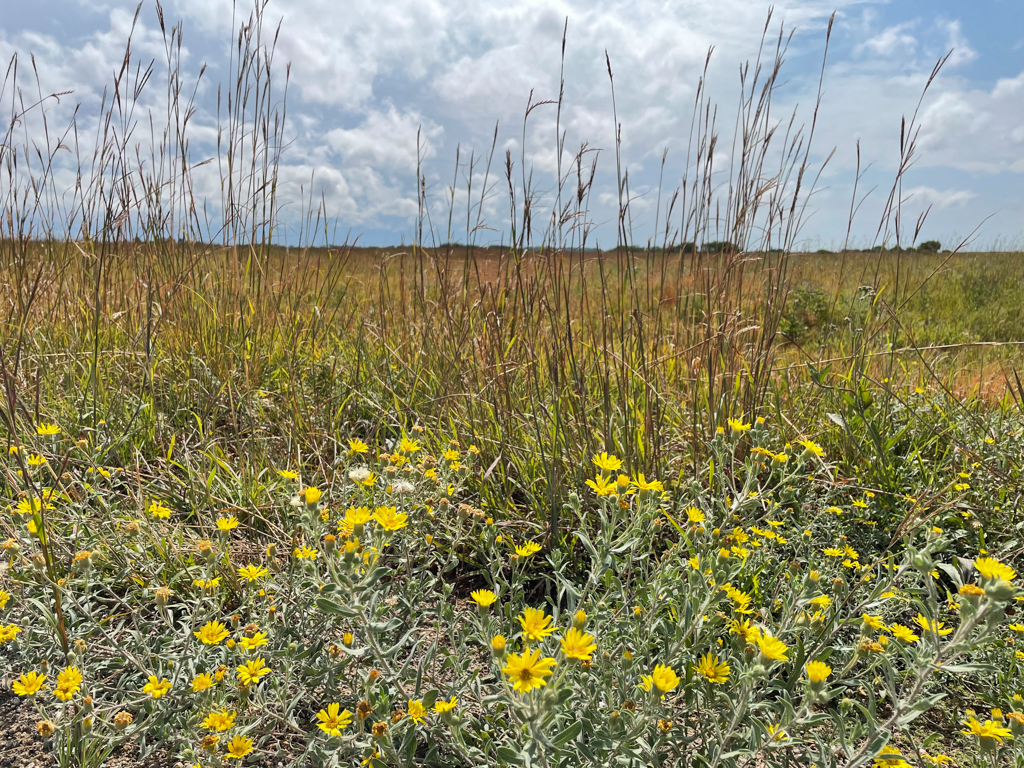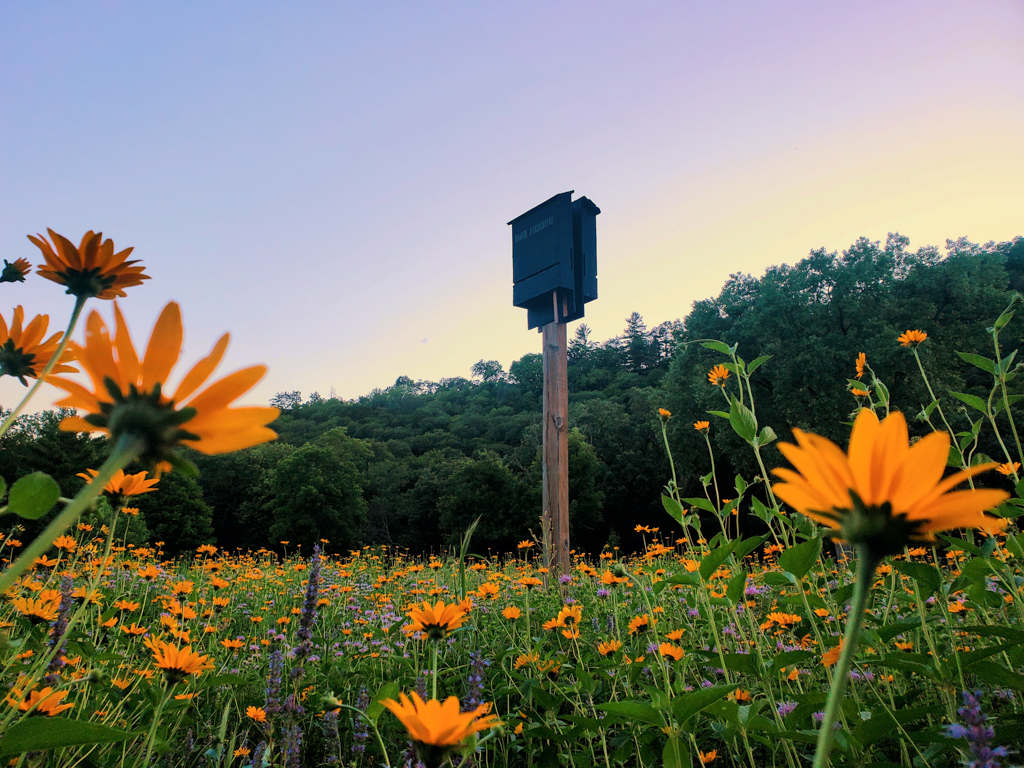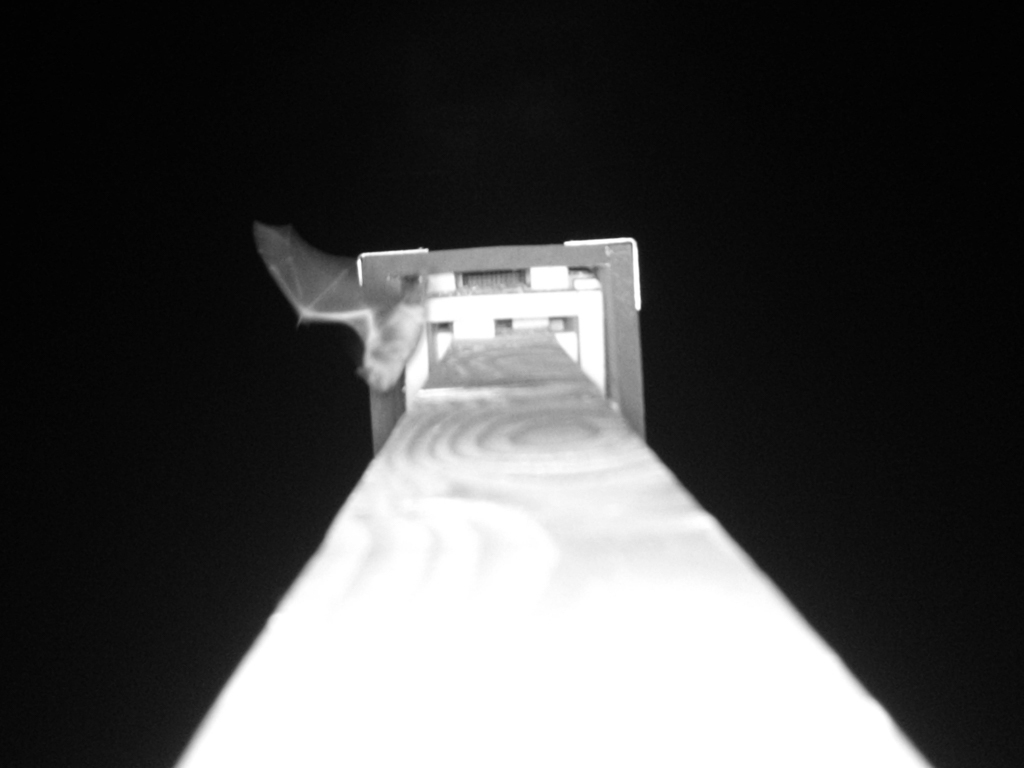|
Summer 2024
NATURE NOTES
Nature Notes is the Minnesota Scientific and Natural Areas Program quarterly newsletter.
In this issue:
|
|
 |
A Natural Symphony: Soundscape Ecology on a Minnesota Prairie
Rebecca J. Romsdahl, Professor of Environmental Science and Policy at the University of North Dakota
Walk into the prairie landscape with the warm summer sun on your back. Close your eyes, and listen - what do you hear? Cicadas and katydids buzz, meadowlarks sing a flute-like melody, crickets chirp, and the air is filled with the wispy rustling of tall grasses as they dance with the wind. These are pieces of the prairie soundscape, a collection of all the natural sounds (and sometimes human sounds) in this place. Studying these place-based sounds is called Soundscape Ecology.
 Hairy golden aster (Heterotheca villosa) blooming among big bluestem (Andropogon gerardii) on Bluestem Prairie SNA. Photo by Rebecca Romsdahl.
During the warm months of summer, I have been tuning in to the soundscape of Bluestem Prairie SNA near Moorhead, Minnesota. The preserve is covered in mixed grasses and flowers, including purple stalks of great blazing stars, clusters of little bluestem grass with their feathery white seedheads, golden prairie sunflowers, and perfectly curved clumps of prairie dropseed grass. This site has sections of reconstructed prairie, converted from farmland. Some of these sections have been reconstructed recently, while others were done over a decade ago. Other areas are prairie remnants, ancient grasslands that have never been disturbed by a plow, with big bluestem grass standing four to six feet tall and waving its turkey-foot seedheads in the slightest breeze.
I use two ecoacoustic recording devices to listen to the soundscape. The recorders are large, stone-gray, and hold four D-batteries. Each recording unit is also housed in a metal strongbox to protect it from wildlife, so they are quite heavy. Happily, this year I have replaced them with two new mini recorders. Each plastic box is roughly the size of a 3 x 5-inch notecard. The units are waterproof and can be set for different recording times, such as an hour at sunrise and again at sunset. I set them to record at 30-minute intervals, 24 hours per day and leave them in the field for five to seven days at a time. Then, I use a couple of online AI-powered ecoacoustic platforms to analyze my recordings. For example, the phone app Merlin is a great tool for identifying birdsongs. I often use it when I go for a walk in the SNA as well!
 Rebecca Romsdahl holding an ecoacoustics recorder. Photo courtesy of Rebecca Romsdahl.
In spring, I have captured an orchestra of songs from migrating birds stopping over and those who have returned to their nesting areas, such as sedge wrens, sandhill cranes, killdeer, Wilson’s snipe, and red-winged blackbirds. In summer, my recordings are dominated by wind rushing through the grasses and the many insects who buzz, click, chirp, and hum. These include species like the shiny black common field cricket, the occasional whining buzz of the dog-day cicada, or some katydids with great names, like sword-bearing conehead and gladiator. I have recorded the sound of plump raindrops hitting the metal box, great claps and rolling rumbles of thunder, and thrashing downpours of heavy rainstorms.
Because we humans are so prevalent, nearly every soundscape in the world includes us in some way. The site where I record is not far from active farmsteads, so I have also recorded some human sounds, like a dog barking or a tractor working a field. Inevitably, my soundscape recordings also contain the roar of small planes passing overhead, a train rumbling and blaring its horn in the distance, and occasionally the low hum of busy interstate highway traffic a few miles away.
You may wonder, why capture all these recordings? Listening to the orchestra of natural soundscapes can help us study the health of ecosystems. For example, do we hear the different animals, insects, and burbling stream that we expect to find in a place at this time of year? If not, what has changed? I am exploring how nature conservation strategies are changing as we face global climate disruption. Are remnant and reconstructed grasslands, like Bluestem Prairie SNA, providing good habitat for a wide variety of animals and insects? Can soundscape ecology help us continue to improve our nature conservation efforts? I hope to gain insights on these questions by listening to soundscape recordings from a variety of different grasslands, such as remnants, urban parks, and other reconstructed prairies. I also plan to develop soundscape education materials to remind people of the joy of listening to nature. Nature sounds are also positive for human health, reducing blood pressure and improving mental fatigue. Next time you go outdoors, close your eyes, and open your ears. What do you hear?
Back to top
Building Better Bat Boxes: Happiness is a Warm Roost
Melissa Boman, DNR Natural Resources Specialist
As the sun drops below the horizon, the chattering begins to get louder. Anticipation builds as I watch the box silhouetted against the pink sky, listening to the flutelike song of a veery take center stage at last light. I wait patiently, taking in all the cues of the transition to night: the twilight on the horizon, the still air, and the symphony of mosquitoes in my ear. At last, the first dark blur drops out of the box. Let the count begin! One… two… three... four-five-six-seven… sixty!
 A bat box in a field of wildflowers at sunset. Photo by Melissa Boman, MN DNR.
Counting bats emerging from a roost at sunset is always an enjoyable experience. These surveys give us insights into bat populations and a unique glimpse into their lives. Bat populations have been on the decline in Minnesota since 2016 - largely due to White-nose syndrome (WNS). Nearly 10 years after the arrival of this bat-specific disease to winter hibernation sites, overwintering bat populations have declined more than 90%. As a result, it is now more important than ever to collect information on our surviving bat populations and to ensure that they have adequate reproductive habitat.
Bats have unique needs for their reproduction. During summer months, female bats gather in groups known as “maternity colonies” to give birth and raise their young, known as “pups”. Born hairless and completely dependent on milk from mom, pups need very warm temperatures to grow quickly so they can then learn to fly before hibernation season begins in September. Natural roosts include sun-exposed, large diameter trees with tight crevices that bats can crawl into and safely tuck their pups away from predators. Bats have figured out that human buildings are excellent roosts with warm and stable temperatures, however they aren’t always welcome guests. Bat boxes are an excellent way to provide habitat for bats as they’re excluded from buildings.
 A bat leaving a bat box. Photo by Melissa Boman, MN DNR.
Easy to build and deploy anywhere, bat boxes have gained popularity as a tool to participate in bat conservation. These structures provide critical summer reproductive habitat for bat species impacted by WNS — like the little brown bat, which can live more than 30 years and only produce one pup each year. As interest in boxes has increased, so have questions about the best design practices, where to place them, what size they should be, and how to get bats to move in. In 2021 the Minnesota Biological Survey and Division of Parks and Trails teamed up to investigate bat boxes installed in state parks across Minnesota. With the help of park managers, resource specialists, and naturalists, we documented 136 bat boxes across 28 state parks. After completing an inventory, we took a closer look at box characteristics such as design, color, volume, placement, and the number of boxes installed at each site. Data collected during this project has identified critical surviving bat colonies and illuminated new ideas for how we can optimize bat box installations to attract bats and meet their reproductive needs.
This project has found that maternity colonies prefer choices – gravitating towards groups of bat boxes that they can move between throughout the seasons. We also found that colonies prefer larger boxes with multiple chambers. Small boxes are mostly uniform in temperature while larger boxes have higher temperature gradients from top to bottom and front to back, giving bats more microclimate choices within the roost. Bats seemed to prefer three designs in particular: Four-chamber nursery box, Johnson box, and 2-chamber rocket box. Providing multiple designs installed as a group can provide variety.
We hope insights from this project can benefit bats by providing high quality summer habitat for species facing precipitous population declines. As insectivores, these bats provide critical ecosystem services such as reducing our need for pesticides by consuming agricultural pests and aiding forest regeneration through reducing insect densities and defoliation of trees. Meeting the reproductive needs of bats through better box recommendations might be one way to ensure Minnesotans can benefit from these ecosystem services for generations to come.
 A bat inside a bat box. Photo by Melissa Boman, MN DNR.
Final guidance materials will be published at the conclusion of this LCCMR funded project in July 2025. In summary, the preliminary tips below could help optimize your bat box installations:
- Install boxes in groups or clusters with a minimum of 4 boxes, consider multiple designs.
- Larger boxes are better for maternity colonies (>3,000 in3). Avoid using single chamber boxes or multi-chamber boxes with low volume (<2,000 in3).
- Vary placement related to solar exposure, ensuring at least one box gets good morning sun (east aspect) and another gets good afternoon shade.
- Install boxes with entrances 12-15ft from the ground.
- Avoid painting boxes black, instead choose a light brown, green, or grey to prevent boxes from getting too hot, especially boxes placed in full sun.
- Add passageways between chambers by drilling >3/4” inch holes on each interior panel to allow bats to move between chambers.
- Consider innovative ways to insulate boxes, such as this water-jacket design.
- An extra-large bat box like a “Bat Condo” combined with multi-chamber boxes may be beneficial for scenarios where a large colony is being evicted from a building.
Back to top
|